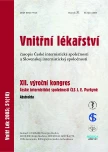Prevalence and associated factors of self medication with antibiotics in Czech Republic
Authors:
R. Andrajati 1,2; J. Vlček 1; F. M. Haaijer-Ruskamp 3
Authors‘ workplace:
Katedra sociální a klinické farmacie Farmaceutické fakulty UK, Hradec Králové, přednosta doc. RNDr. Jiří Vlček, CSc.
1; Pharmacy Department University of Indonesia, Indonesia, přednosta Dr. Maksum Raji Ph. D.
2; Clinical Pharmacology Department University of Groningen, Netherlands, přednosta prof. Dr. D. de Zeeuw
3
Published in:
Vnitř Lék 2005; 51(10): 1096-1101
Category:
Original Contributions
Overview
Self medication with antibiotics (ATB) in Czech Republic (CR) is not approved by law. During the past era a very strong ATB policy and strict control of ATB use in the CR. The objectives of this study were to determine prevalence and to identified factors related of actual self medication with antibiotics and ‘at risk’ self medication with antibiotics.
Method:
crosss sectional design, two stage sampling, selecting a representative region, a middle size city (urban) and rural area sampling. Self administered postal questionnaire were randomly sent to to adults age ≥ 18, 1 000 respondents in urban and 1000 in rural area. Descriptive, bivariate and multivariate analysis was completed using SPSS 11.5 version.
Results:
The prevalence of ATB use with prescription was 28.0 % and actual ATB self medication was 0.5 %. The prevalence at risk of self medication with ATBs: storage ATB at home was 7.5 % and intended ATB use for themselves was 16.9 %. Amoxicillin was the most frequent of antibiotic use whereas throat symptom/complain was the most frequent reasons for use ATBs. Storage ATBs at home sources were from medical prescription, relative and from pharmacy without any prescription. The most frequent of storage ATBs at home was co-trimoxazol. The most comonly indication to use ATB without consultation with a physician was sore throath. The predictor of the ATB use with prescription were male, people which had children at home, suffered from chronic diseases, and storage ATB at home. Respondents less 35 years old, who used ATB with prescription, intended use ATB, were determinants of storage ATB at home. The people with ATB at home was predicted to be actual self medication. The predictors of intended use ATB by adults were people age less than 65 years and storage ATB home.
In conclusion, the prevalence of actual self medication with AB was low but „at risk“ self medication was higher in the ČR. The people with age less than 35 years were strong predictor for storage ATB at home and intended use ATB without consulting a physician. The people which storage ATB at home were predicted to be actual self medication.
Key words:
self medication – antibiotic – Czech Republic
Sources
1. Figueiras A, Caamano F, Gestal-Otero JJ. Sociodemographic factors related to self-medication in Spain. Eur J Epidemiol 2000; 16: 19-26.
2. Gonzalez AO, Lozano MAR, Nunez JG. Analysis of automedication with antibiotics in Spain Enferm. Index Microbiol Clin 1998; 16: 328-333.
3. Grigoryan L, Haaijer-Ruskamp FM. 18 co-investigators in Europe on behalf of Self Medication with Antibiotic. Self medication with Antibiotics in Europe. Pharmacoepidemiol Drug Safety 2004; 13: S19.
4. Liu YC, Huang WK, Kunin CM. Inappropriate use of antibiotics and the risk for delayed admission and masked diagnosis of infectious diseases. Arch Intern Med 2001; 16: 2366-2370.
5. Macfarlane J, Holmes W, Macfarlane R et al. Influence of patients‘ expectations on antibiotic management of acute lower respiratory tract illness in general practice: questionnaire study. BMJ 1997; 315: 1211-1214.
6. Mainous III AG, Hueston WJ, Davis MP et al. Trends in antimicrobial prescribing for bronchitis and upper respiratory infections among adults and children. Am J Public Health 2003; 93: 1910-1914.
7. Marliere GLL, Ferraz MB, Quirino dos Santos J. Antibiotic consumption patterns and drug leftovers in 6000 Brazilian household. Adv Ther 2000; 17: 32-44.
8. McCaig LF, Besser RE, Hughes JM. Trends in antimicrobial prescribing rates for children and adolescents. JAMA 2002; 287: 3096-3102.
9. Richman PB, Garra G, Eskin B et al. Oral antibiotic use without consulting a physician: A survey of ED patients. Am J Emerg Med 2001; 19: 57-60.
10. Steinman MA, Landefeld CS, Gonzales R. Predictors of broad-spectrum antibiotic prescribing for acute respiratory tract infections in adult primary care. JAMA 2003; 6: 719-725.
11. Steinman MA, Gonzales R, Linder JA et al. Changing use of antibiotics in community-based outpatient practice. Ann Intern Med 2003; 138: 525-533.
12. Stratchounski LS, Andreeva IV, Ratchina SA et al. The inventory of antibiotics in Russian home medicine cabinets. Clin Infect Diseas 2003; 37: 498-505.
13. WHO fact sheet no 194 revised January 2002: Antimicrobial resistance. http://www.who.int
14. WHO global strategy for containment of antimicrobial resistance. 2001: http://www.who.int/emc
Labels
Diabetology Endocrinology Internal medicineArticle was published in
Internal Medicine

2005 Issue 10
Most read in this issue
-
Fokální síňová tachykardie
Klinické projevy, místa vzniku a výsledky katetrové ablace - Comparison of catheterisation and surgical treatment of ostium secundum type atrial septal defect in adult patients
- Prosthetic Mitral Valve Endocarditis
- Prothrombotic status as part of metabolic syndrome
